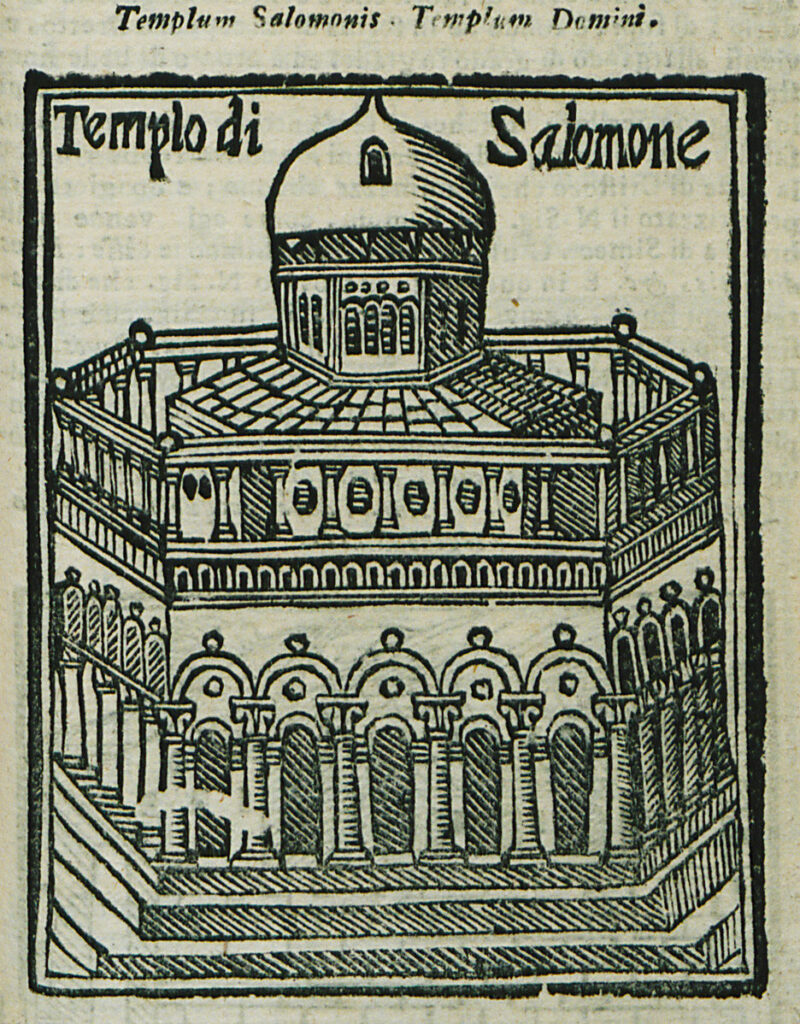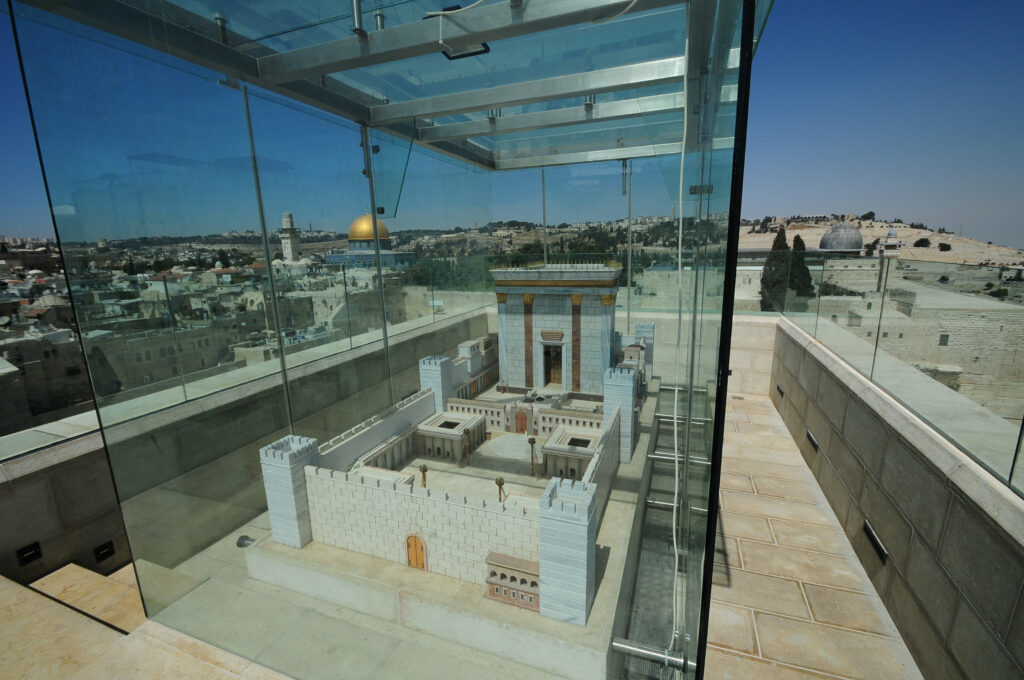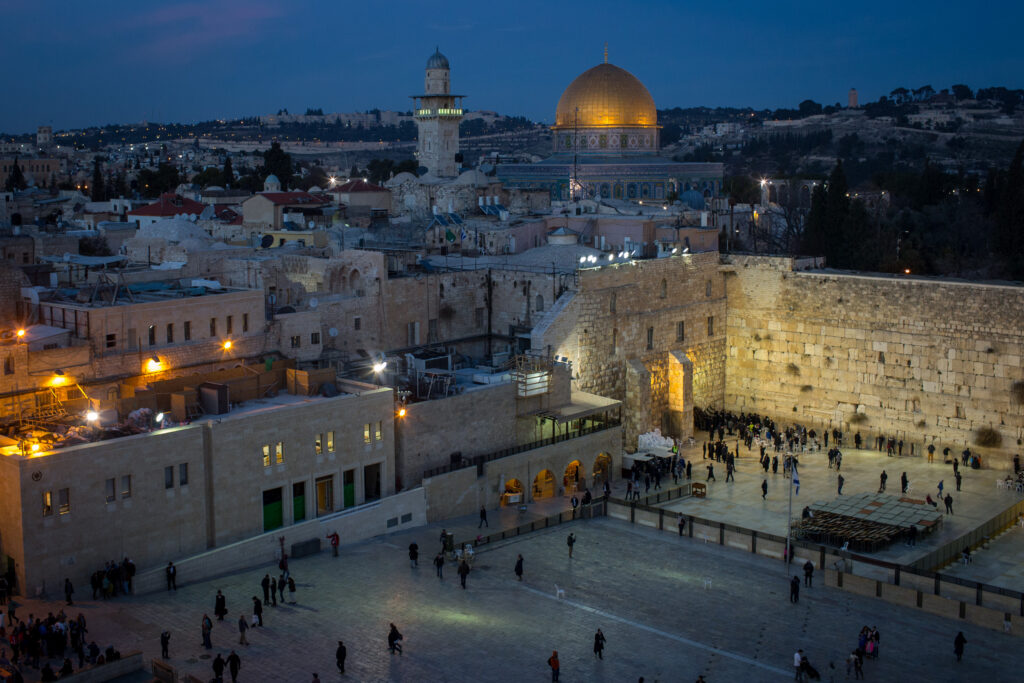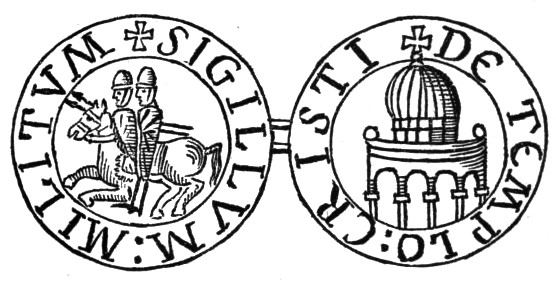
A stereo card of the Dome of the Rock from the late 19th century. Wikipedia.
This is part one of a two-part essay on the depiction of the Temples in Jerusalem in art made primarily for Christians. Part two, focused on specific examples of concepts outlined in part one, is here.
It’s 1979, and I’m in Israel for the first time. I am there on a Zionist tour for high-school seniors. We’ve gone to the Western Wall for Friday evening services, where I’ve had my initial experience of the male-bonded intensity of yeshiva-style dancing. Our group is now being hosted for dinner at the home of wealthy Americans who have emigrated to Israel. They live in a vast apartment directly overlooking the Temple Mount. Before dinner, I am assisting the maid in preparing plates of gefilte fish at the kitchen counter, and I find myself directly in front of an arched window, framed in Jerusalem stone. Through the window is a view so iconic as to seem positively unreal: highlighted against a sky of dark blue velvet and dramatically moonlit, is the golden Dome of the Rock—the Qubbat al-Sakhrah—the mosaics on its octagonal architrave so vivid and close that, had I been able to read Arabic, I would have been able to understand the words so beautifully figured upon it.
Those words, mostly quotations from the Quran, adorn the entire perimeter of the structure. Facing south, towards the kitchen window from which I gazed, were the words of a particular Surah, inscribed in monumental Kufic letters the height of a tall person—Surah al-Ikhlas—“The Unity”: “In the name of God, the Beneficent, the Merciful. Say: God is One. The One upon Whom all depend. God begets not, nor is begotten, and none is like God.”
I have since come to understand that, in this particular location, that verse is not only a theological statement, but an adversarial religious argument. For in 691 CE, when the Dome of the Rock was completed and adorned with this passage, if one stood under that inscription and looked south, one would note that Jerusalem was already dominated by another large, impressive dome.
The other dome was the cupola surmounting the Church of the Holy Sepulcher, which had by then occupied for over 350 years what Christian tradition asserted was the site of Jesus’ crucifixion. It was the holiest spot in Christendom, proclaiming Christ’s divine Sonship and identification with God’s Self.
When the Umayyad caliph Abd al-Malik (r. 685-705 CE) raised the Qubbat al-Sakhrah, he built a dome higher and larger than that of the Holy Sepulcher, thus offering an architectural rejoinder to the doctrinal statement made by the Christian monument: “You say that God has a Son? This is false. The Prophet has definitively and finally established the truth—God’s unity is a perfect and ultimate unity. God is a unique entity, the source of all being, who creates all creatures, but is not a created being, and who thus has neither parents nor children.” Abd al-Malik built the Qubbat al-Sakhrah as Islam’s theological billboard—a clarion broadcast in support of the idea of God’s incomparable Oneness.
The Caliph’s choice of a text to adorn his building was thus deliberate and polemic, rejecting Christianity’s foundational claim, the divine Sonship of Jesus, and hearkening back to an ideal of absolute Divine Unity. His choice of site was no less considered and retrospective. The Dome was built on the only site higher than Golgotha—the hill on which the Holy Sepulcher had been built. This was the Temple Mount, so-called because it had once housed the two since-destroyed Jerusalem Temples of the Jews. So firm was this association that it was called by Muslims Bayt al-Makdis. This appellation derives from, and is analogous to, the Hebrew Beit Ha-Mikdash (“the Holy House”) and refers, indisputably, to those Jewish Temples. In acknowledgement of that same, foundational history, the crusaders who established the First Kingdom of Jerusalem (1099-1187) would call the conquered and occupied Dome of the Rock Templum Salomonis (“the Temple of Solomon”) or Templum Domini (“the Temple of the Lord”)—“the Lord” referring not to the Israelite God generally, but to Jesus, this being the Temple that was known to him and visited by him during his earthly life.

The Temple of Solomon anachronistically depicted as the Dome of the Rock in a print by Salvatore & Giandomenico Marescandoli of Lucca, 1600. Wikipedia.
The Templars, in fact, called themselves “The Knights of the Temple of Christ.”
At age fifteen, gazing in wonderment at the Temple Mount out of the kitchen window, I was unaware of those layers of nuance and association. But something else did strike my eye: a framed poster, hung on the wall next to the window. It depicted the identical view I was looking at, but with the Dome of the Rock replaced by a photograph of another building—the Second Jerusalem Temple. I would later learn that the image of the Temple in this montage was a photograph of the famous 1:50 scale model of the Second Temple designed (and continuously updated,) by a team led by the Hebrew University archaeologist Michael Avi-Yonah since 1966. At that time, it was located in the garden of the Holyland Hotel in Bayit VeGan, Jerusalem, and moved in 2006 to the Israel Museum.

A view of a model of the proposed Third Temple on display in Jerusalem’s Old City in 2007. Mendy Hechtman/Flash90.
So, before me, “in real life” was a view so iconic that I was already familiar with it before I ever set foot in Jerusalem. Then, next to it, a new image—a vision, simultaneously of the past and the future—that challenged the Dome of the Rock, itself erected in order to challenge the cupola crowning the Church of the Holy Sepulcher. My hosts’ photograph portrayed history as prophecy. It depicted the once and future Temple.
Had I known enough to perceive the politics of my hosts, I would have understood that their views were not representative of most American Jews, or Israelis for that matter. Nonetheless, my eyes were opened to the image, and I started to notice this poster in more and more places beyond the Old City: in falafel joints and drugstores, in lottery kiosks, and even a “kosher” yoga studio in Nachlaot. This vision of what once was and what could again be seemed to have captured the imaginations of a wide swath of religiously observant Jerusalemites.
Looking back on that night in Jerusalem, I have come to realize that the desire to erase the present and replace it with a particular past is not unique. It is the impulse that led al-Malik to construct the Dome of the Rock on the identical physical footprint of the heart of the Jewish Temples—the stone of sacrifice—the principal focus of Jerusalem’s Jewish past. And the text chosen to decorate the Dome “answered”—and was meant to succeed, usurp, and render heretical or irrelevant—the major monument of (what was then) Jerusalem’s Christian present. The photomontage of the restored Second Temple imagined that the same thing could one day be accomplished in a new context made possible by the restoration of the Jews to their historical homeland.
The photomontage has an unexpected precedent in the history of visual culture. Depictions of Christian churches as the Jewish Temple occur with surprising frequency throughout the history of Christian art, if one is attuned to them.
On the surface, such depictions would seem to pay homage to Christianity’s ancient Jewish past, and in a sense, they do. But that homage is also diminished by an understanding of the Jewish past as merely anticipating the Christianity that is yet to come, and the Temple as but an adumbration of the Church that would replace it. These depictions, no less than the photomontage in that beautiful Jerusalem apartment, present a vision of what should stand on the Temple Mount, as opposed to what does.
But since 691, Jews and Christians have had to reckon with the fact that a building already stood on the Temple Mount. From that day to this, the Dome of the Rock had a physical reality in the way the destroyed Temples or the Church-yet-to-come did not. And so in art made for both Jews and Christians, the Jewish Temples of yore began to be depicted in the guise of the Dome of the Rock.
The Dome of the Rock as the ancient Jewish Temple (for Jews), or the ancient Jewish Temple as foreshadowing the Church (for Christians), requires following a train of admittedly circuitous historical imaginings. It is, after all, a Muslim edifice “posing” as a Jewish building that has validity in a Christian context only in the sense that it points to the Church that was thought to supersede it. Moreover, the use of the Dome of the Rock to represent the Jewish Temple is doubly surprising because the Temple was known—and not just by scholars—to have been utterly destroyed in antiquity. The fact of the Temple’s destruction was, of course, a reality very much present in the consciousness of Jews, who prayed—daily and on each major festival—for its restoration of the Temple, and who fasted four times a year in solemn commemoration of its destruction. But the destruction of the Temple was no less obvious to Christians, who read both the New Testament as well as the Jewish historian Josephus, and who knew that Jesus had prophesied in the Gospel of Mark that of the Temple not a stone would be left unturned.
Yet, in spite of what Jews and Christians knew about the historical facts of the destruction of both Jerusalem Temples, the extant Dome of the Rock was seen by both groups as an avatar of the buildings that once resided there. It is perhaps understandable why the Christian imagination was prepared to see the Dome of the Rock as a suitable manifestation of the Temple they believed to foreshadow the Church. And that is because the Church being foreshadowed was more than a building, it was an idea, a hope, a promise. The Ecclesia was ultimately undepictable, it was a community of faith that, under God’s grace, was to unite all people on the face of the earth.
Having established this unfolding of the Christian imagination, with the architectural features of the Dome of the Rock depicting the ancient Jewish Temple, itself an allegory for the spiritual dominion of Christianity, we are nearly ready to look at how this scene was further refined and customized according to the local cultural aesthetics of Renaissance painters. But we must first add one other important component, which has to do with Christianity’s theological self-understanding as both incorporating and succeeding Judaism.
Just as the New Testament was added to the Hebrew Bible in order to make an encompassing, new-old Christian Bible, so an architectural representation of the Christian “fulfillment” of “completion” of Judaism was added onto representations of the Temple. Now, the Temple was not simply a singular structure, but it was seen as having two parts, an older and newer, with more “antique” architecture representing the Temple and its Old Dispensation, and the addition of more “Christian” architecture representing the New Dispensation.
That is where regional variation comes in, for “Christian” buildings in Northern and Southern Europe emerged out of different architectural traditions. Northern artists tended to depict the Temple as a combination of a Dome of the Rock-like structure, often with Romanesque features, with an added Gothic façade. Italian masters preferred to show the Temple in classical Graeco-Roman style, as a tempio or a quasi-symbolic, gazebo-like tempietto, the New Dispensation represented less by the architecture than by the New Testament narratives occurring in the space.
Each modality—the High Gothic and the classicizing—was intended to evoke “the once and future Temple.” The High Gothic was the prevailing style in the North in the 15th and 16th centuries. Thus, to the Northern viewer, the Temple-as-High Gothic cathedral would have read as contemporary. Romanesque features represented the Old, having been derived from (Roman) antiquity, thus extending the legacy of pagan Rome reborn as Christian Rome in the West. That is why, in Northern painting, you’ll often see architectural features of the Dome of the Rock rendered in Romanesque style.
Things were quite different, even reversed, in the Italian Renaissance, which championed the revival of classical antique architecture. The Gothic elements that seemed so contemporary in the North in the early decades of the 1400s would have appeared, to the Italian viewer of 1500, as out of date. Because Gothic was not contemporary but “ancient” for early-16th-century Italians, when viewing or depicting the Jewish Temple as a High Gothic edifice, they would think of the scenes from the Christian narrative unfolding there as transpiring in “the ancient Jewish Temple.”
At the same time, in the Italian Renaissance quest to revive the even older style of classical antiquity, the architectural elements of ancient Greece and Rome became the new and contemporary again. For Southern artists, locating biblical events in a classical (and not Gothic) setting, thus, cast them as both antique and contemporary, situating them in a sort of visual “past continuous,” a fitting style to evoke the theological “once and future” history of the Temple and its promise in the Church.
Thus, we have Northern painters construing a hybrid Temple according to the visual cues that, to them, signified past and present: a Romanesque inflection of the Dome of the Rock represented the old, and the High Gothic cathedral representing the new. In the South, that same Gothic style was thought of as old, and the very ancient classical architecture of Greece and Rome, now revived and reborn, was seen as new.
Finally, we come to a difficulty encountered by all painters—Northern and Southern—and in seeing how they dealt with it, we can open a window onto the Renaissance theological and artistic mind. The problem: decoration. Recall that, particularly in the North, the newer, Christian additions to the Temple were rendered in the style of the Gothic Cathedral. Cathedrals, as everyone knew, were full of beautiful furnishings—tapestries, stained glass, statuary, and precious manuscripts, stones, and metals—which bore the images of Christ and the saints and told the Christian story. Christians rarely conceived of the Temple in a manner that accorded with what they knew of history from Scripture. They more usually retrojected onto the ancient Jewish Temple the decoration of their own cathedrals, as well as the style and function of the beautiful objects that filled them.
This was partly because most Renaissance Christians knew relatively little about the actual, living Jewish religion. But descriptive and polemic literature reveals that they were familiar with at least two important things about Jewish doctrine—aniconism, that is, the categorical refusal of the so-called “graven image,” and, of course, the rejection of the messiahship and divinity of Jesus.
From the Old Testament, Christians knew that the Jews had received and had “clung to” the Law, and that primary among the commandments of that Law—coming directly after the commandment to believe in God—was the prohibition of the “graven image.” Nonetheless, the thought that Jews would not have had any visual images at all in their holy places seems to have strained Christian credulity in a way that even Jewish disbelief in Jesus did not.
Christians could accept that there were disbelievers in the world. They could see how idolaters might venerate the “wrong” images, and, in fact, frequently depicted such misguided worship in imagined scenes of pagan or idolatrous rituals. But the idea that a space consecrated for worship could be utterly without images was inconceivable to them.
Thus, Christian knowledge of Jewish aniconism was trumped by the conviction—among image-creating and -consuming Renaissance Catholics—that the ecclesiastical function of any church was defined by visual images. To the Renaissance Christian mind, there could be no worship space, neither Christian church nor Jewish Temple, without images.
Once we have arrived at the point where we understand that Northern Renaissance painters thought it logical to depict the Temple as a Gothic cathedral, and we further understand that as a Gothic cathedral images were necessary because they define it as a worship space, we are now in the position to ask which images would fittingly decorate the Temple of the painter’s imagination—aside, that is, from the accoutrements of Ark and lampstand, altars, and vessels mentioned in the Bible.
The answer to this question arose from the other important thing that Renaissance Christians knew about Jews, that they rejected the claim that Jesus was the Messiah, the Son of God, part of a triune Godhead. Thus, it was clear to Christians that it was theologically implausible for Jews to have had images of Christ or the saints in their holy places.
Also, Christians were aware that the Temple existed before Christianity as well as during the unfolding of the Christian story, simply because many events of the Gospels and the Apocrypha are depicted as occurring within its precincts. Images of Christ and the saints would, logically, be absent from Christian visualizations of the Jewish Temple because the events on which they are based had not yet transpired, or were just occurring at the time of the narratives depicted.
So, while images would have been de rigueur for Christians imagining any house of worship, images of Christ and the saints, the very staples of decoration in Renaissance churches and cathedrals, would have been implausible in the context of the Jewish Temple. Consequently, Christian artists needed to determine what were the appropriate subjects of the “Jewish devotional images” that they imagined adorning the Temple space. These subjects, as we will see in tomorrow’s installment, came from the Old Testament, and, for the most part, they were deliberately unflattering to Judaism.
We’ll see in some detail how Christian artists imagined the “Jewish” spaces in which they situated the foundational Christian story. On certain rare occasions, the depictions are based on the contemporary lives of real European Jews, and thus they provide a glimpse into actual Jewish sacred and domestic interiors. But, as depictions of Jewish spaces are more often the product of the imagination of the Christian artists, they suggest the extent to which Christians thought of Judaism as a sort of proto-Christianity without the figure of Jesus.
To be continued on Friday, July 31.


